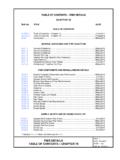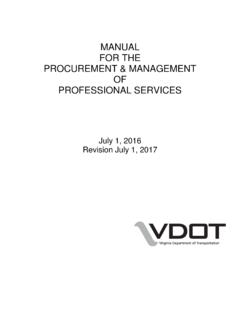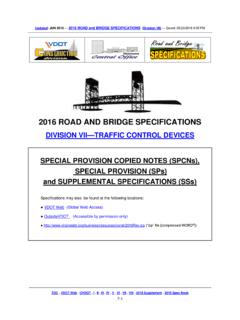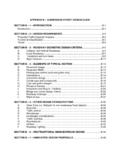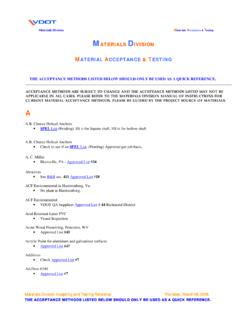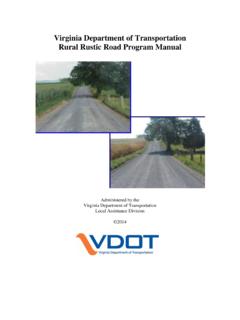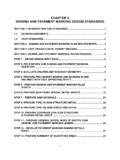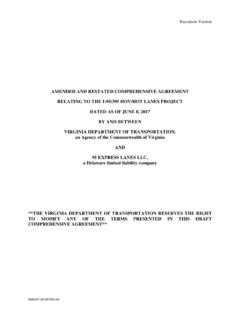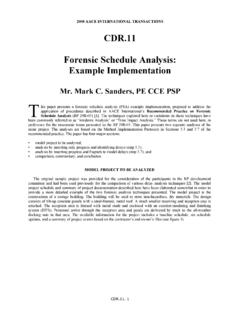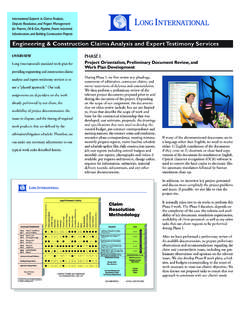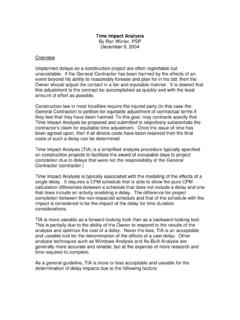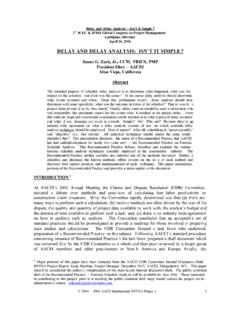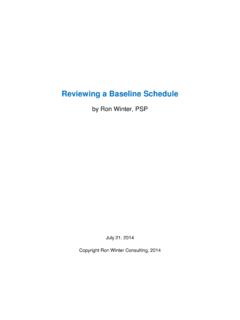Transcription of SCHEDULE IMPACT ANALYSIS 7.27.06
1 VIRGINIA POLYTECHNIC INSTITUTE AND STATE UNIVERSITY An equal opportunity, affirmative action institution Invent the Future College of Engineering VDOT-VT Partnership for Project Scheduling Charles Edward Via, Jr. Department of Civil and Environmental Engineering 200 Patton Hall (0105) Blacksburg, Virginia 24061 540/231-0923 Fax: 540/231-7532 E-mail: The Principles of SCHEDULE IMPACT ANALYSIS TR-07-03 A report presented to the Virginia Department of Transportation and the VDOT-VT Partnership for Project Scheduling Advisory Board May 2007 Frank J. Arcuri John C. Hildreth Virginia Tech Abstract Not all construction projects finish on time, within budget. Delays and changes occur during construction that IMPACT the SCHEDULE , consequently impacting the project in its completion. SCHEDULE IMPACT ANALYSIS is the process of quantifying and apportioning the effect of delay or change on a project SCHEDULE .
2 Although not all events that differ from the planned SCHEDULE of work will result in a SCHEDULE IMPACT , this report emphasizes how to identify and classify potential SCHEDULE impacts, as well as how to determine what, if any effect they have on the project completion date. A review of common SCHEDULE IMPACT ANALYSIS techniques, along with examples, provide the reader with an appreciation for properly implemented analyses that analyze the effect of a delay or change, at the time of the event, using the most relevant SCHEDULE information. The purpose of this document is to present the results of this review and recommend to VDOT which SCHEDULE IMPACT ANALYSIS technique should be employed. 2 DISCLAIMER The contents of this report reflect the views of the authors, who are responsible for the facts and the accuracy of the data presented herein. The contents do not necessarily reflect the official views or policies of the Virginia Department of Transportation, the Commonwealth Transportation Board, or the Federal Highway Administration.
3 This report does not constitute a standard, specification, or regulation. 3 TABLE OF CONTENTS 1 INTRODUCTION 2 TERMINOLOGY 3 SCHEDULES Baseline SCHEDULE Maintaining the SCHEDULE of Record Developing an As- built SCHEDULE 4 SCHEDULE IMPACTS Understanding SCHEDULE Impacts Types of SCHEDULE Impacts Delays Disruptions Change Suspensions Termination Causes of SCHEDULE Impacts Contractor Owner Third Party / Force Majeure Classifying SCHEDULE Impacts Excusable, Non-compensable Delays (ED) Excusable, Compensable Delays (ORD) Non-Excusable, Non-Compensable Delays (CRD) Non-Excusable, Compensable Delays (some ORD) Concurrency Concurrent Delays Apportioning Concurrent Delays 5 SCHEDULE IMPACT ANALYSIS TECHNIQUES Review of Methods Retrospective Methods Global IMPACT Approach Net IMPACT Approach Adjusted As-Planned CPM Approach Adjusted As- built CPM Approach Collapsed As- built (But-for) SCHEDULE Approach Contemporaneous Methods Impacted Updated CPM (Veterans Administration) Approach Modification IMPACT ANALYSIS ( Army Corps of Engineers ) Approach Time IMPACT ANALYSIS Approach Comparison of Methods 6 SUMMARY AND RECOMMENDATIONS 7 REFERENCES 4 LIST OF FIGURES Figure 1: Overview of SCHEDULE IMPACT ANALYSIS .
4 5 Figure 2: SCHEDULE of Record Flowchart .. 12 Figure 3: Sources of Information used to Develop As- built SCHEDULE .. 14 Figure 4: Classification of 22 Figure 5: As-Planned CPM Network for Drainage Structure 25 Figure 6: As- built CPM Network for Drainage Structure 25 Figure 7: Drainage Structure Example Delays .. 25 Figure 8: Concurrent Delays .. 27 Figure 9: Apportioning Concurrent Delays .. 29 Figure 10: SCHEDULE IMPACT ANALYSIS Techniques Comparison .. 31 Figure 11: Train SCHEDULE Example TIA Techniques .. 32 Figure 12: Drainage Structure Example Bar Chart and Delays .. 35 Figure 13: Diagram Key .. 36 Figure 14: Global IMPACT Approach .. 37 Figure 15: Net IMPACT Approach .. 38 Figure 16: Adjusted As-Planned CPM 39 Figure 17: Adjusted As- built CPM Approach .. 41 Figure 18: Collapsed As- built SCHEDULE (But-for) Approach .. 43 Figure 19: Impacted Updated CPM (Veterans Administration) Approach.
5 45 Figure 20: Modification IMPACT ANALYSIS ( Army Corps of Engineers ) Approach .. 48 Figure 21: Time IMPACT ANALYSIS 51 Figure 22: Results of TIA Techniques for Drainage Structure 52 5 1 INTRODUCTION From a scheduling standpoint, the goal of every project is to be delivered on time and within budget, with desired functionality and acceptable quality level. In an ideal world, projects follow early starts and early finishes, float is not consumed, deadlines are met, the contractor never files claims for time extension, and the owner never assesses liquidated damages. Such a scenario rarely exists on construction projects events occur that potentially affect the planned completion of work, requiring a need to evaluate the impending IMPACT of this event on the project SCHEDULE . SCHEDULE IMPACT ANALYSIS is defined as the process of quantifying and apportioning the effect of delay or change on a project SCHEDULE .
6 Although not all events that differ from the planned SCHEDULE of work will result in a SCHEDULE IMPACT , this document is written to identify events that will have an IMPACT , show what that IMPACT is, and assign responsibility for the IMPACT . Figure 1 summarizes the key elements of a SCHEDULE IMPACT , in bar chart format. The As-Planned (Baseline) SCHEDULE includes the entire planned duration of the project, while the As- built to Date represents the duration of work that has been completed to the present time. At this present time , it is realized that the project may not finish on time, and the owner wants to know when the project will be delivered. Events have taken place, which are determined to IMPACT the remaining SCHEDULE , as shown by the To Build bar. As stated before, a SCHEDULE IMPACT ANALYSIS is the process of quantifying and apportioning the effect of this delay.
7 The Total IMPACT quantifies the effect that these events have had on the projected completion date of the project, and it is now time to apportion responsibility for why the project will be delivered late. Figure 1: Overview of SCHEDULE IMPACT ANALYSIS As-Planned (Baseline) As- built to Date To Build Total IMPACT Mine Yours Apportioning Responsibility 6 Without implementation of a proper SCHEDULE IMPACT technique, it is difficult, if not impossible, to accurately quantify and apportion the IMPACT that a delay or change has on the completion of a project. Too often are time extensions and damages assessed based on simplistic measures, such as robotically using the total duration of a delay for granting the number of days for a time extension, rather than considering all influences on the project and its SCHEDULE and addressing the delay using a method that utilizes a critical path ANALYSIS .
8 CPM scheduling forms the backbone of both this document and of effective SCHEDULE IMPACT ANALYSIS techniques. The critical path method s ability to accurately represent living, growing projects are what makes it ideal for determining how an event may potentially IMPACT project completion. This report emphasizes how to identify and classify potential SCHEDULE impacts, as well as how to determine what, if any effect they have on the project completion date. In Chapter 3, discussion of the key elements of baseline schedules, updated and revised schedules of record, and as- built schedules show the reader the importance of properly maintaining these documents in a manner that will be most beneficial when claims are filed for time extensions or damages. Maintaining SCHEDULE documents are essential to any successful claim or defense against claim, as courts have upheld that regularly updated and maintained schedules most accurately portray the project in its completion.
9 Chapter 4 discusses the different types and causes of SCHEDULE impacts. Whether caused by the owner, contractor, or another source out of their control, there are different types of events that may IMPACT the SCHEDULE . After events are identified, they are then classified into categories of excusable/non-excusable and compensable/non-compensable delays. Doing so prepares the delays for a SCHEDULE IMPACT ANALYSIS . Eight different SCHEDULE IMPACT ANALYSIS techniques are reviewed in Chapter 5, which use a common, basic example to show how each method is implemented. Techniques vary in their use of CPM schedules, utilizing as-planned and as- built schedules in both retrospective and contemporaneous manners. A comparison of methods will give insight into the results of the ANALYSIS , followed by recommendations of the most accurate SCHEDULE IMPACT techniques, discussed in Chapter 6, which show clear advantages to using certain techniques instead of others.
10 7 The intended audience for this report is executives and managers who want an overview of the principles of SCHEDULE IMPACT ANALYSIS and how they are applied, in order to have a better understanding of information presented by SCHEDULE analysts. This document is not intended to prepare the reader to perform a SCHEDULE IMPACT ANALYSIS of an actual project, but to educate on the fundamentals of SCHEDULE impacts and their use in accurately determining the potential effect a delay or change has on the SCHEDULE and on timely project completion. 2 TERMINOLOGY This chapter will define key terms that are used throughout the report. It is assumed that the reader has knowledge of the principles of planning and scheduling. If this is not the case, a precursor to this report is the technical report An Introduction to the Management Principles of Scheduling by Brian Munoz, VDOT-VT Partnership for Project Scheduling.
